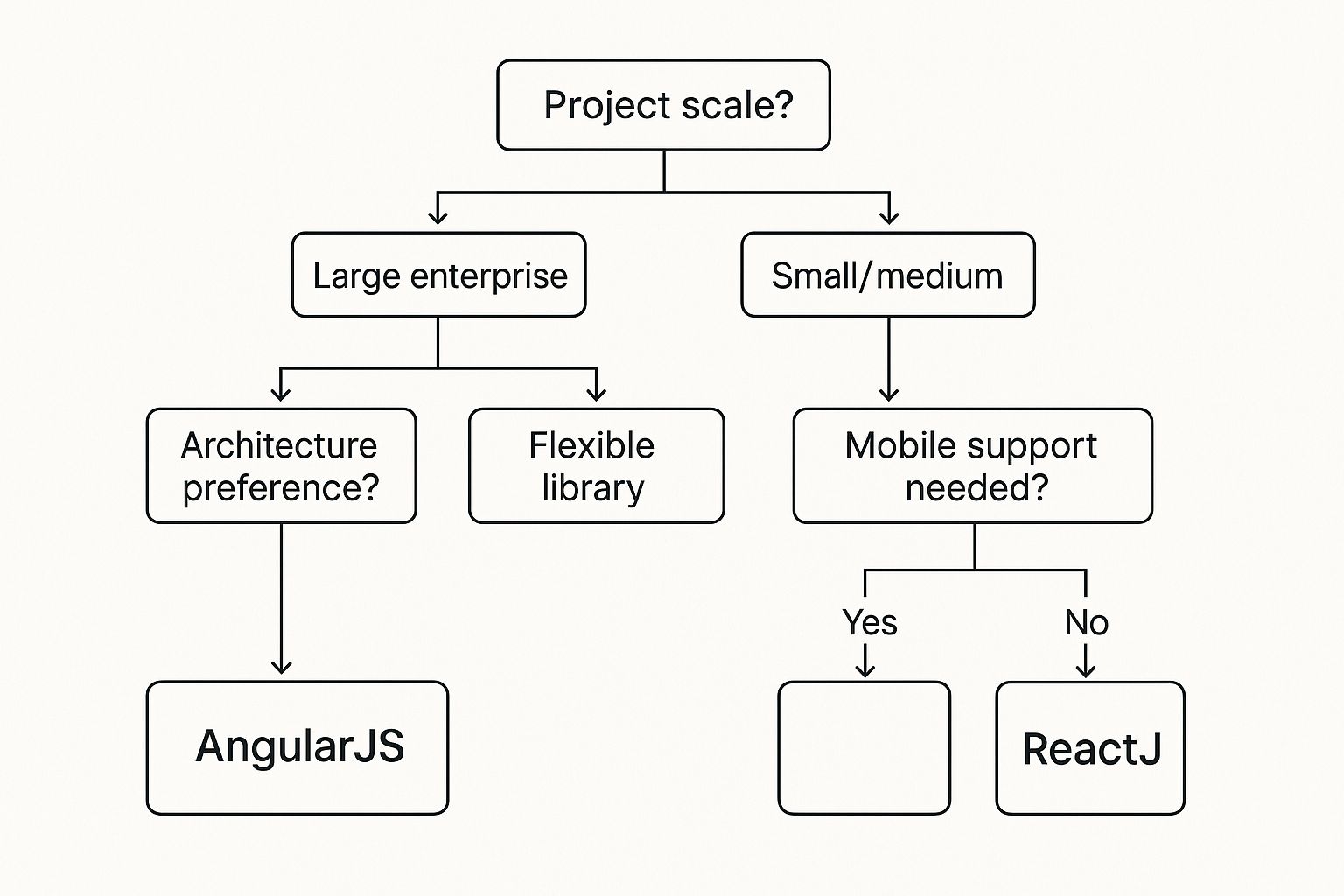Let's get straight to the point in the AngularJS vs ReactJS discussion: ReactJS is the go-to for any new web application, period. AngularJS, on the other hand, is a legacy framework you’ll likely only encounter when maintaining older projects. ReactJS brings superior performance and flexibility as a UI library, while AngularJS is a more rigid, all-in-one framework that has officially reached its end of life.
Choosing Your JavaScript Powerhouse

Making a choice here really comes down to deciding between a prescriptive, structured framework and a lean, focused library. AngularJS, originally from Google, gives you a complete Model-View-Controller (MVC) architecture right out of the box. It tells you exactly how to structure your application, providing built-in features like two-way data binding and dependency injection.
ReactJS, created and maintained by Facebook, takes a completely different approach. It’s a JavaScript library that does one thing and does it exceptionally well: building user interfaces (which is the 'View' part of MVC). This laser focus gives developers immense flexibility. You get to hand-pick the best libraries for other tasks like routing and state management, building a custom tech stack that perfectly fits your project's needs.
This core philosophical difference is exactly why one has become a relic while the other powers so many of the web applications we use daily. If you're weighing your options for a new project, you can see how they stack up against other modern tools in our guide to the https://kpinfo.tech/best-web-application-frameworks/.
The adoption numbers tell the story pretty clearly. By the end of 2019, ReactJS was already running on over 1 million websites, while AngularJS usage had fallen to around 517,000. This trend was especially pronounced in tech-forward regions. For instance, in Russia, the market share for React grew significantly faster than for Angular, highlighting the global shift in developer preference. To see how developer experience plays a crucial role in these decisions, check out a developer's guide comparing Expo and React Native for some great insights.
AngularJS vs ReactJS Key Differences at a Glance
For a quick summary, this table breaks down the fundamental distinctions between these two technologies. It’s a high-level look at why developers now overwhelmingly choose React for new projects.
| Attribute | AngularJS (Legacy) | ReactJS (Modern) |
|---|---|---|
| Type | A comprehensive MVC Framework | A focused UI Library |
| Data Binding | Two-way data binding | One-way data flow |
| DOM | Uses the real DOM | Uses a Virtual DOM |
| Learning Curve | Steep, with many concepts | Easier to start, ecosystem required |
| Best For | Maintaining existing applications | All new web development projects |
Ultimately, the table confirms what most experienced developers already know: AngularJS had its time, but ReactJS represents the present and future of building dynamic, high-performance web UIs.
Architecture and Philosophy: Framework vs. Library
At the heart of any AngularJS vs. ReactJS discussion lies a fundamental philosophical split. AngularJS is a comprehensive framework, while ReactJS is a specialised library. This isn't just a matter of semantics; it completely shapes how you build, structure, and think about your applications.
Think of AngularJS as an all-in-one toolkit for building a house. It gives you the foundation, the walls, the plumbing, and the electrical wiring—all designed to work together in a specific way. It enforces the classic Model-View-Controller (MVC) architectural pattern, providing a rigid but highly structured environment for large-scale projects. This "batteries-included" nature means it has built-in solutions for routing, state management, and data fetching, so many architectural decisions are made for you right from the start.
Working within this system enforces consistency, which can be a huge win for large development teams. The trade-off, however, is flexibility. You have to build things the "AngularJS way," which can feel restrictive if you want to swap out parts or try a different approach.
The AngularJS MVC Structure
The MVC architecture in AngularJS neatly divides your application into three distinct, interconnected parts:
- Model: This is the brain of the operation, holding all the application's data and business logic. It's the ultimate source of truth for your app's state.
- View: The View is simply what the user sees—the user interface. Its job is to display the data held in the Model.
- Controller: Acting as the middleman, the Controller takes user input from the View and tells the Model what to change.
One of the defining features of this structure is its famous two-way data binding. This mechanism creates an automatic, real-time sync between the Model and the View. If a user types into an input field (the View), the underlying data in the Model updates instantly, and if the Model's data changes, the View reflects it immediately. While this sounds incredibly convenient for simple forms, it often becomes a major headache in larger apps. The automatic updates can trigger unpredictable, cascading changes, making it difficult to track down performance bottlenecks.
Key Takeaway: AngularJS's two-way data binding creates a tight link between the Model and View, where a change in one instantly updates the other. This can feel magical at first but often leads to complex performance issues as an application grows.
The ReactJS Library Approach
ReactJS takes a completely different path. It doesn't bother with the entire MVC pattern; it’s a library laser-focused on one thing and one thing only: the 'V'—the View. Its entire purpose is to help you build user interfaces efficiently by managing UI components and their state. This minimalist approach hands the power back to you, the developer. You get to choose your own preferred tools for the Model and Controller aspects, like using Redux for state management or React Router for handling navigation.
ReactJS is built around a powerful concept: component-based architecture. You construct your UI by creating small, self-contained, and reusable pieces called components. A button, a dropdown menu, or even a whole user profile card can be its own component. You then assemble these components, like LEGO bricks, to build out complex interfaces.
This modularity is a game-changer. It makes your code dramatically easier to understand, test, and reuse across your project. On top of that, ReactJS uses one-way data flow. Data is passed down from parent components to child components, creating a clear and predictable path. When you need to debug, it's far easier to trace where your data came from and how it changed, avoiding the tangled mess that two-way binding can create.
Finally, ReactJS introduced JSX (JavaScript XML), a syntax extension that lets you write what looks like HTML directly inside your JavaScript files. This keeps a component's logic and its presentation markup neatly bundled together in one place, which many developers find makes the code more readable and intuitive to work with. Choosing between AngularJS's rigid framework and ReactJS's flexible library is one of the first and most critical decisions you'll make, and it has lasting implications for your project.
Diving Into Performance and Rendering
When we get down to the brass tacks of AngularJS vs ReactJS, performance is where the two really part ways. The core difference boils down to how each one talks to the browser's Document Object Model (DOM) – essentially, the live, structural map of a webpage.
AngularJS takes a direct approach, working straight on the real DOM. Whenever something in your app’s state changes, AngularJS tells the browser to update the corresponding chunk of the actual DOM tree. For a small app, this is fine. But for complex applications with lots of dynamic data, this process can really bog things down.
What adds friction is AngularJS's signature two-way data binding. To make sure the data model and the user interface are always aligned, it uses a technique called "dirty checking." It scans every value it's watching for changes, and if it finds one, it has to run the scan again just in case that change triggered another one. You can see how this can spiral into a performance headache as an application grows.
How React’s Virtual DOM Changes the Game
ReactJS brought a brilliant solution to the table: the Virtual DOM. Instead of messing with the slow, real DOM for every little thing, React keeps a lightweight copy of it in memory. Think of it as a blueprint.
When your application's state shifts, React doesn't touch the browser right away. First, it creates a new snapshot of the Virtual DOM. Then, it runs a clever "diffing" algorithm to compare the new blueprint with the old one, pinpointing exactly which UI elements have actually changed.
Only after it knows the bare minimum that needs updating does React go to the real DOM. It batches all these changes together and applies them in one swift, optimised move. This dramatically cuts down on the expensive work the browser has to do, making the whole user experience feel much snappier.
By keeping interactions with the browser's real DOM to a minimum, React achieves a rendering speed that AngularJS just can't keep up with, especially when you're dealing with huge datasets or frequent UI updates.
What This Means in the Real World
This performance difference isn't just a number on a benchmark test; it’s something users feel. Let's imagine you're building an e-commerce site with a product grid showing hundreds of items, complete with filters and sorting toggles.
- With AngularJS, clicking a filter would kick off a full dirty-checking cycle. The browser would have to redraw large sections of the DOM, and the user would likely feel a slight, but noticeable, delay.
- With ReactJS, the same click triggers a quick Virtual DOM comparison. Only the product cards that need to change are touched on the real DOM, making the UI feel practically instant.
Bundle size also plays a big part. Russian developers I've spoken with often point to ReactJS’s much smaller footprint – typically around 30-40 KB gzipped, versus AngularJS's heavier 150-200 KB – as a key advantage for projects where performance is paramount. In competitive Russian markets like e-commerce and fintech, that snappy, responsive feel you get from React's Virtual DOM directly impacts customer satisfaction. You can find more detail on the common ground between AngularJS and ReactJS in other resources.
So, if speed and a fluid user experience are at the top of your priority list, React’s performance architecture gives it a clear, undeniable edge over the older approach of AngularJS.
Navigating the Developer Experience

Technical specs only tell half the story. The day-to-day reality of writing code is what really determines how a project feels and, ultimately, how successful it is. When we compare the developer experience of AngularJS vs ReactJS, we find two completely different philosophies, each with its own trade-offs between the initial learning phase and long-term productivity.
AngularJS has a reputation for its steep learning curve, and it's well-deserved. To get started, you have to wrap your head around a whole new vocabulary of concepts: directives, services, modules, and dependency injection. It’s a lot to take in at once. But once you’re over that initial hump and fluent in the "AngularJS way," its rigid, opinionated structure gives you a clear, standardised road map for building things.
ReactJS, on the other hand, is much easier to dip your toes into. If you know some JavaScript and can grasp JSX, you can start building simple components almost immediately. The real challenge with React isn't starting; it's scaling. Because it's just a library, you're responsible for choosing and integrating a whole ecosystem of other tools to build a full-fledged application.
The Learning Curve and Ecosystem
The journey from novice to expert looks very different for each. With AngularJS, the hard work is all upfront. You need to commit to a deep dive into its comprehensive framework before you can become truly productive.
ReactJS lets you ease in with a more gradual slope. You can start small and build up. But to build anything complex, you'll need to master a handful of other tools that aren't part of React itself. This almost always includes:
- State Management: For any non-trivial app, you’ll need a library like Redux or MobX. Each of these comes with its own set of concepts to learn.
- Routing: React Router is the de facto standard for managing navigation and URLs in a single-page app.
- Build Tools: Getting comfortable with tools like Webpack and Babel is non-negotiable for setting up and optimising a modern React project.
ReactJS effectively asks the developer to be an architect, piecing together a bespoke solution from a massive ecosystem. AngularJS just hands you a complete, all-in-one toolkit and tells you how to use it.
Community Support and Long-Term Viability
This is where the angularjs vs reactjs debate gets really clear-cut. ReactJS is backed by one of the largest and most active developer communities on the planet. This translates into a nearly infinite supply of resources—tutorials, open-source libraries, and answers to just about any problem you could imagine on sites like Stack Overflow. If you run into a bug, chances are someone has already solved it and written about it.
AngularJS, in stark contrast, reached its official End-of-Life (EOL) back in December 2021. It no longer gets official updates or support from Google. While a small community still exists to keep legacy projects afloat, it’s a shadow of its former self. Trying to solve a new problem or integrate with modern tools can feel like shouting into the void.
For any project with a future, the vibrant, ever-growing ecosystem around ReactJS provides a crucial safety net and a constant source of innovation. This alone makes it the definitive winner for long-term development and future-proofing your application.
Understanding Market Demand and Career Paths

When you’re weighing up AngularJS against ReactJS, the job market tells a very clear story. For developers, your technical skills are your currency, and the demand for these two technologies has created two very different career paths.
ReactJS has cemented its place as the go-to for new projects. Job boards are flooded with roles for frontend developers who know their way around React, and that’s true for both agile startups and massive corporations building their next generation of applications.
This demand is easy to understand. React's performance, flexibility, and the broader ecosystem—which includes React Native for mobile apps—make it a powerful choice. Learning React opens you up to a much wider variety of projects and roles focused on creating fresh, modern user experiences.
The Diverging Career Trajectories
The career path for an AngularJS developer, on the other hand, looks quite different these days. Expertise in AngularJS has become a niche skill, but it's a valuable one, especially for developers working on large, legacy enterprise systems that need maintenance and modernisation.
Plenty of established companies, particularly in finance and government, are still running critical applications built with AngularJS. These organisations rely on specialists to keep the lights on, push incremental updates, and sometimes, plan the tricky migration to a newer framework.
Key Insight: A career in ReactJS is about building the future of the web, with a constant stream of new projects. A career involving AngularJS is often about preserving the past, offering stability by supporting crucial, long-standing applications.
This isn't just a gut feeling; the data backs it up. According to Stack Overflow’s 2023 developer survey, ReactJS is used by about 40-45% of frontend developers. A quick look at job postings in major Russian cities like Moscow and Saint Petersburg reveals there are roughly 2.5 times more openings for React developers compared to those asking for AngularJS, which is sitting around 17-20% demand. You can dig deeper into these numbers with Radixweb's analysis.
Ultimately, which skill you choose to focus on really depends on your career goals. If you want to be at the leading edge of web development, the choice is pretty obvious. For companies aiming to build new, high-performance applications, getting the right people is key. You can find out more about how to hire a ReactJS developer in our dedicated guide. Aligning your skills with what the industry needs is the surest path to long-term career growth.
Making The Right Choice For Your Project
So, after diving deep into the AngularJS vs ReactJS debate, how do you actually make a decision? It boils down to one thing: your project's specific needs. This isn't about which one is universally "better," but rather which tool is right for the job you have in front of you.
Let's be blunt: for almost any new project you're starting today, ReactJS is going to be the right call. Its performance advantages, enormous community support, and modern architecture make it the industry standard for a reason.
If you're building a sleek new Single Page Application (SPA), crafting a highly interactive UI, or even venturing into mobile development, ReactJS is your best bet. Its component-based structure and use of a Virtual DOM are precisely why it's so good at creating fast, scalable, and easy-to-maintain applications.
So, when would you ever pick AngularJS in this day and age? Really, there's only one practical scenario: you're working on a large, existing enterprise system that was built with it years ago. In these situations, a complete rewrite is often off the table due to time and budget. Your job is to maintain and extend what's already there, making AngularJS a necessity, not a preference.
Visualising Your Decision
Sometimes a visual guide helps cut through the noise. This decision tree lays out the choice based on your project type, architectural needs, and whether mobile is on your roadmap.

As you can see, unless you're locked into a legacy enterprise system, the path almost always points to ReactJS. This is especially true if you need flexibility or have mobile ambitions. One of the killer features of the React ecosystem is the ability for building apps with React Native, which can be a massive win for your project's scope and budget.
For new projects, the verdict is clear: ReactJS's flexibility and performance-oriented design make it the default choice for modern web development. AngularJS's role is now confined to supporting legacy systems.
To help you make that final call, here’s a quick-reference table that maps common scenarios to the recommended technology.
Decision Guide Which Technology Fits Your Project
| Project Scenario | Recommended Choice | Key Reason |
|---|---|---|
| New Single Page App (SPA) | ReactJS | Superior performance with Virtual DOM and a massive, modern ecosystem. |
| Maintaining a Legacy System | AngularJS | Necessary for working within the existing codebase of an older application. |
| Cross-Platform Mobile App | ReactJS | Direct path to mobile development using React Native for code sharing. |
| Small, Interactive Widgets | ReactJS | Lightweight and can be easily integrated into existing websites. |
| Team Prefers MVC Architecture | AngularJS | The framework is built on a traditional Model-View-Controller pattern. |
This table should make it clear where each technology shines. Choosing the right tool from the start is a critical first step towards a successful project.
Picking a framework is a big decision that impacts everything from development speed to long-term maintenance. If you're still weighing your options, you might find our broader guide on choosing the https://kpinfo.tech/best-framework-for-web-application/ development helpful.
Frequently Asked Questions
When you dig into the AngularJS vs ReactJS debate, a few common questions always seem to pop up, especially concerning where these technologies stand today. Let's clear up some of the most frequent points of confusion.
What's the Difference Between AngularJS and Angular?
This is a big one, and it causes a lot of mix-ups. AngularJS (or Angular 1) is the original framework we've been discussing, which officially hit its end-of-life in 2021. Think of it as the first generation.
Angular (everything from version 2 onwards) is a totally separate beast. It was a complete, ground-up rewrite by the same team at Google. Modern Angular is a component-based framework much like React, but it’s built entirely in TypeScript. They might share a name, but they're fundamentally different under the hood. Moving from AngularJS to modern Angular isn't a simple update; it's a full-scale migration project.
Is It Still Worth Learning AngularJS Today?
Honestly, for anyone just starting out, the answer is a straightforward no. You'd be much better off spending your time learning React or modern Angular. That's where the vast majority of new projects and job opportunities are.
That said, there's a niche where AngularJS skills are still surprisingly valuable. Many large companies still have massive, business-critical applications running on it. If you're interested in a career maintaining or modernising these legacy systems, knowing AngularJS could actually set you apart.
Final Takeaway: For any new development, the AngularJS vs ReactJS discussion is pretty much settled. React's modern architecture, stellar performance, and massive community make it the clear winner for building scalable web apps today. AngularJS really only comes into play if you're working on maintaining older, existing systems.
Can You Use TypeScript with React?
Absolutely. While React itself is a JavaScript library, it has fantastic, first-class support for TypeScript. In fact, using TypeScript with React has become incredibly popular.
Why? It adds static typing, which helps you catch silly mistakes and bugs early on in the development process. This drastically improves your code's quality and makes large applications much easier to manage, especially when you're working with a team. It's a huge win for maintainability.
At KP Infotech, we specialise in building high-performance web applications using modern technologies like React. Whether you need a dynamic user interface or a complete digital transformation, our expert team can help you build the right solution. Discover how we can bring your vision to life at https://kpinfo.tech.
